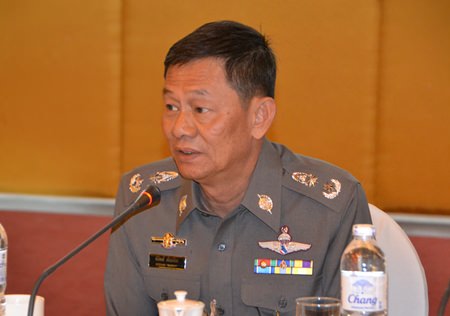Tourism dominated the most-recent meeting of Pattaya’s business and political leaders after final statistics for 2014 showed an even-steeper drop in visitors from Russia.
Russian arrivals in Thailand plummeted 27.4 percent year-on-year in December as the ruble currency crisis deepened. The plunge followed 21.2 percent and 23.3 percent year-on-year drops in November and October, respectively.
 Pol. Maj. Gen. Nitipong Niamnoi, commander of Chonburi’s provincial police, joins the discussion with Pattaya business operators and listens to complaints about traffic problems in Pattaya.
Pol. Maj. Gen. Nitipong Niamnoi, commander of Chonburi’s provincial police, joins the discussion with Pattaya business operators and listens to complaints about traffic problems in Pattaya.
December’s decline also contrasted sharply with tourist arrivals from every other major market, which all recovered from the December 2013 when 36 countries issued warnings against Thailand travel due to violent street protests in Bangkok.
The Pattaya Business & Tourism Association, meeting at the Grand Sole Hotel Jan. 14 – the day the December and year-end figures were released – was told that tourism revenue in 2014 fell more than 2 billion baht, representing a 30 percent decline from a year earlier.
According to the Ministry of Tourism and Sports, tourist arrivals fell 6.7 percent in 2014 to 24.78 million tourists, down from 26.55 million in 2013. Every important market for Pattaya’s tourism sector tumbled including Russia (-8.2 percent), India (-10 percent), South Korea (-13.7 percent), and Japan (-17.7 percent), with China – thanks only to a whopping 86.5 percent surge in December – down just 0.3 percent.
PBTA members were told the Tourism Authority of Thailand is projecting 28 million tourists in 2015, a 13 percent increase. Tourism revenue is projected to climb 16 percent to 1.35 trillion baht.
There were no country-specific numbers available for Pattaya arrivals, but the city’s biggest three markets are, in order, China, Russia and India. However, TAT statistics show Pattaya last year was visited by 7.4 million people: 4.3 million of foreigners – a 40 percent drop – and 3.1 million Thais.
PBTA members were told TAT is scrambling to create new international marketing plans to offset the losses. Other measures being looked at include tax cuts, ASEAN regional promotion, fuel-price reductions, and opening new markets in China.
Based on 2014’s numbers, Thailand has a long way to go to regain business in Asia. The entire East Asia region fell 8.5 percent in 2014 and the ASEAN region 9.1 percent. China, in particular, had been 5.6 percent down, as of the end of November, and only ended virtually flat thanks to the arrival of 495,034 Chinese during December.
With Thais now accounting for more than 41 percent of Pattaya’s visitors, TAT naturally also is looking to build its domestic success.
Domestic tourists posted a 7 percent increase last year, the PBTA meeting was told. TAT forecasts a 9 percent increase in 2015 and a 14 percent increase in revenue.
The meeting was told the first two weeks of 2015 have started strong, but still cannot be considered traditionally “normal.” TAT said it will work with businesses to promote their products and services to tourists from Eastern Europe, the Middle East, Russia, Indonesia, Scandinavia, China, India and Germany.
TAT Pattaya already has plans to joined trade shows in Indonesia, Eastern Europe, China and South Korea. For domestic marketing, it will stress art and cultural tourism and visitors from the northern and upper-central regions.
Chonburi’s provincial police commander, Pol. Maj. Gen. Nitipong Niamnoi, said Pattaya can do more to boost tourism itself, but solving chronic problems, such as traffic, which he described as “descending into crisis.”
Tour buses remain a major problem, Nitipong said, continuing to park wherever they like despite much-publicized “crackdowns” on illegal parking. He said Second Road’s lack of lane-dividing lines also creates havoc.
Pattaya Deputy Mayor Verawat Khakhay blamed lack of funding, saying the city needed more money to repaint lanes after Second Road was resurfaced. He didn’t say when that funding might appear.
Nitipong also called for better regulation of car-hire companies, which he claimed are renting to tourists who may not understand traffic laws and cause accidents.
He said if there were measures to control car-hire operators and a requirement that the driver must understand traffic rules and regulations, it should help raise awareness and improve safety.




